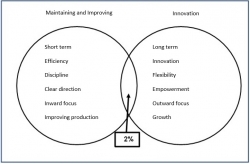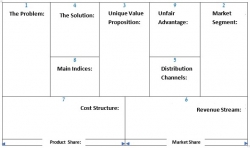This article is based on the book "Inside the Box" by Jacob Goldenberg and Drew Boyd, describing the method developed by SIT.
A few years ago I worked with a company called Fair Marketing, expending export markets for an innovative product they had been developing - Just Eye Fashion: the product includes a glasses frame with detachable temples, so that anyone can choose a frame in a certain design, and temples in a different design, or several temples, and change them when desired.
Although this idea was not invented by Fair Marketing, they were among the first in the world to adopt it. They came upon the innovative product while looking for a product to open up new markets for them on the global level, and to create a difference in the competitive and crowded local market.
Division added a large variety of new possibilities
Creating the opportunity for each client to design a personal look, with a large variety and a sense of independence and customization, "lit up" the client pool. It allowed the company to easily offer a large variety and to match products with different local fashions. For example, a colorful variety for Germany and a more conservative line for Scandinavia.
Dividing the product to its two parts, which traditionally would have been one whole (the frame and the temples), and the possibility to create different and varied pairings, created something different. Unlike the usual product. This was a case of very interesting innovation. It enabled the company, for instance, to offer clients a vast number of choices for a relatively low cost.
At the same time, this new method gave clients a feeling of independence and customization. Creating "a personal look".

Overcoming the "Natural" Fixation
Dividing a whole product or service to its components allows us to create something new. A better or more suitable product or service. We're used to looking at the product as a whole and often find it difficult to see other possibilities. That is a structural fixation.
The division tool enables us to overcome the structural fixation, the idea that a certain product or service can't be changed.
A month ago I published an article on the subtraction tool. In it I presented examples for cases where subtracting a component from a product or service opens up new and better opportunities.
In this article I'll present an additional tool from the SIT method – division. This technique keeps all of the components we're used to in a product, and is thus easier to conceptualize.
Indeed, looking around, we're surrounded by services and products which had been divided. For example, paying with credit cards divides payment from shopping. Often this division tempts us to shop more. Or a split AC unit which allows for easier and more efficient installation.
The interesting question is how to create a new product or service through the division technique.
SIT – Systematic Inventive Thinking
SIT developed the division technique as a tool for innovative thinking where it's blocked by fixation and paradigms. It's described in the book "Inside the Box" written by Jacob Goldenberg and Drew Boyd, along with other tools developed by the company.
An Example from the Book
Goldenberg and Boyd described a workshop led by Boyd at General Electric. He was invited to talk with forty top marketing executives, at the company’s training center in Crotonville, NY.
The participants, initially doubting the method, chose a refrigerator as a test case.
Boyd asked them to list all the components: door, shelves, fan, freezer, and compressor.
Then, the participants chose the compressor as the component to be divided. That is, the component to be separated from the whole.
They were asked to suggest placements for the compressor when separated from the refrigerator. After much thought, someone suggested they place it outside of the house.
Then Boyd asked the important question, the key point: how would placing the compressor outside of the house benefit clients?
Some ideas were: it won't create heat in the kitchen, it'll be simpler and easier to service or fix, it'll be possible to build a bigger cooling compartment. And then an additional idea was raised, an especially interesting one: placing the compressor outside of the refrigerator will make it possible to cool additional units with it, like a vegetable cupboard, a drinks storage unit, an egg drawer, etc.
This example shows the creativity which can be achieved once we're free of ingrained thought patterns and fixations. The important point is how to use this method when trying to achieve innovation or creatively solve a problem.
How to Use the Division Technique
You can divide and reorganize in two dimensions:
- In space, that is, reorient components in relation to each other.
- In time, that is, when each component operates. Like with credit cards.
Division can be done in three ways:
- Functionally. Focusing on the whole product and the role of each component, by changing the components' order. Such a change can create a new function for a product.
- Physically. By cutting the product and reassembling it. For example, the Just Eye Fashion frames.
- Preserving. Dividing the product into parts that function as a smaller version of it. For example, instead of diners choosing one entree, they're offered Hors d'oeuvre – a collection of small entrees.
Division Step by Step
- First of all, make a list of all the components. It's best to write each one on a separate note and organize them in the familiar order on a board.
- In a functional division – pick a random component and place it in a different spot. Try to do that with your eye closed, without seeing where you're placing it.
- In a physical division – draw a line, "cutting" the product into component groups, and reorganize them according to the line.
- In a preserving division – divide the product into smaller parts.
- If the result is a valuable new product or service, ask yourself how you'd implement it.
How to Kill a New Idea
Take notice, one of the "best" ways to kill a new idea is to prove it isn’t applicable. This is the familiar struggle between innovative thinking and fixation, the drive to stay with what's known, safe, and comfortable. At times it's a struggle between an old and a new generation.
So, thinking about a product's new form needs to be separate from implementation or applicability.
I presented a similar way of thinking in my article on the Blue Ocean strategy – you identify a new product's strategic price so that it's accessible to many buyers. Then set your desired profit. And only then, as a last step, you find a creative way to manufacture the product or provide the service at a cost which will enable you to sell for the strategic price and make your desired profit.
I've discussed the healthy tension between preserving a company's core values, and fixation that can ruin a company, or between careful innovation and responsibility, several times on this blog (see for example this article).
I recommend that every company nurture an innovative yet careful approach. You need to differentiate between personal tensions and adhering to the familiar only because it's comfortable, and a careful examination of new ideas.
Forums for Creative Thinking
The division technique is an excellent one. The crucial question is, of course, how to use it in practice.
Always remember that those leading the company – the top executives – give their best to the company. Their ideas are constantly implemented. They are at the front, dealing with challenges. This is a forum where reaching ground breaking, never before thought of, ideas will be difficult. Every attempt at innovative thinking needs a wider forum.
When meeting with this wider forum, begin with silent brainstorming – a technique that allows for a wide variety of ideas. Another way is to divide the forum into smaller groups (three or four participants) and have each group brainstorm and develop ideas. This is also a way to allow for most participation to be heard.
If you only work with the top management forum – you'll have low chances of breakthroughs. The same will happen if you meet with a wide forum, but have everyone shouting out ideas.
Summary and Recommendation
In this article I presented the division technique, a tool developed by SIT, to promote innovative thinking.
Developing new products or manufacturing techniques and creative problem-solving are any company's life-blood. A company that stops investing in R&D and innovation, is on its last leg.
The division technique can be seen in daily life. Shopping with a credit card, split AC, remote controls. At the same time, we must remember that the first step, a company's ground breaking idea, is always an innovation. It's likely that in those cases, too, there was resistance to that innovation.
When you want to innovate, engage those employees who aren’t usually involved in solving the company's problems. Use tools from my blog.
If your company doesn’t have anyone capable of leading such discussions or forums, I suggest you hire a professional consultant.
If you are interested in my professional help, personally or for your company, the best way to contact me is to send a request through the Get in Touch form here.












 My First Book: Manage! Best Value Practices for Effective Management
My First Book: Manage! Best Value Practices for Effective Management